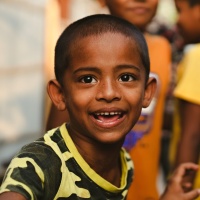International Day of Street Children

The International Day of Street Children (January 31 in the Czechia, April 12 in the World) reminds us of the dramatic situation of millions of children living in slums in degrading conditions. Worldwide, this problem affects more than 330 million children, 100–150 million of whom live directly on the streets. These children lack access to basic education, face unsafe working conditions, violence, abuse, malnutrition, disease, crime and drug addiction.
Children on the streets of the world's slums
According to statistics, approximately 1 to 1.2 billion people live in slums around the world, including 330 million children (UN-HABITAT, 2023). In Bangladesh, one of the most densely populated countries, 13 to 14 million people live in slums (UNICEF, 2023). The capital, Dhaka, is home to 4 million slum dwellers, 1.5 million of whom are children. Of these children, 500–600,000 live directly on the streets of the world's noisiest city.
Children living on the streets often earn their living by begging, collecting garbage, petty trading, stealing or working in the informal sector. Without homes and family support, they face daily stress and fear for survival in inhospitable conditions that have an enormous impact on their physical and mental health.
Adverse effects
Living on the streets has serious and lasting consequences for children. These children are exposed to a wide range of risks that affect their health, development, and opportunities for a better life.
Physical and psychological effects. Children are at high risk of injury while working or begging. Without adequate health care, they are exposed to diseases such as malnutrition and infections. Long-term stress from violence, abuse and homelessness can lead to mental disorders such as depression, post-traumatic stress disorder (PTSD) and anxiety (World Health Organization, 2023).
Abuse and exploitation. Children are vulnerable to human trafficking, sexual abuse, and physical abuse. Many are targeted by criminal organizations that use them for prostitution or illegal activities such as drug trafficking (UNICEF, 2023).
Lack of access to education. Children without access to basic education have little chance of escaping poverty. Lack of education is a major barrier to a better life for them (UNESCO, 2023).
Health problems. Lack of sanitation, food and water, and frequent exposure to disease in overcrowded areas lead to infectious and respiratory diseases, malnutrition, and other health problems that have long-term consequences without adequate care (World Health Organization, 2023).
Watch the Pio Squad video clip that gives a glimpse into the reality of children on the streets of Dhaka.
Chalantika: A Light of Hope for Children in Dhaka
Organizations like ADRA strive to help children in slums through projects that include education, nutrition, health care, and growing up in a safe environment. The Chalantika Education Center, which has been operating in Dhaka for 12 years, helps 183 children get an education and better living conditions. This project offers children a space for personal growth and a chance to escape the cycle of poverty and hopelessness.
How can you help?
Helping these children is vital. Every donation helps provide educational materials, nutritious food, medical care and school supplies to the children who need it most.
Education is the key to changing the lives of these children and giving them a chance at a better future. Help and be a part of that change. With the gift of education, you can give the children of Chalantika a better life.
Thank you for helping the children of Chalantika slum!
Sources:
UNICEF (2023). "Children Living in Street Situations."
World Health Organization (2023). "Addressing the health needs of street children."
UNESCO (2023). "Education for Sustainable Development: A Global Review."
UN-HABITAT (2023). "World Cities Report 2023." United Nations Human Settlements Programme.



